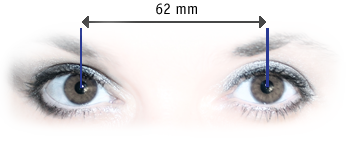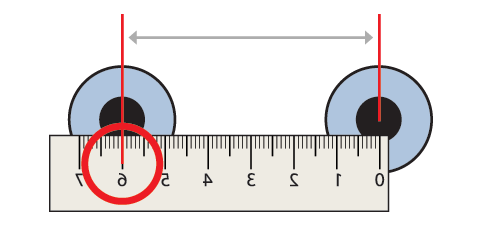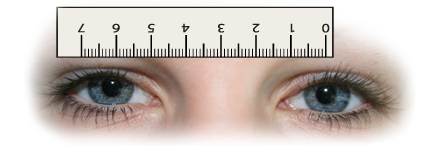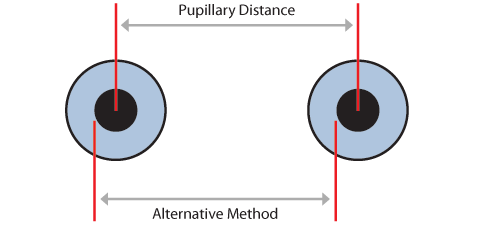|
What is Pupillary Distance? How to Measure PD?
What is my PD?
(also called Pupillary
Distance, Inter-Pupillary
Distance or Pupil Distance)
PD is the distance between
the centre of one pupil to the centre of the other pupil. Prescription
glasses are made so that the distance between the optical centres of
the glasses' lenses, is the same as your PD. PD varies from person to
person but once you are an adult, your PD does not change. Therefore,
as an adult, if you have had it measured, then it will still be the
same, even if your spectacle prescription has changed. Once you know
your PD, you do not need to measure it every time you buy prescription
glasses.
PD is measured either
during the eye test or when prescription glasses are ordered. Obviously
we cannot measure your PD over the internet, so it is best to make sure
your PD is included in your glasses prescription.
The Diagram below represents a PD of 62mm.

If your prescription does
not contain your PD:
- Ask
to have it measured at an optical shop – some may charge a fee.
- Contact
an optical shop where you have previously purchased prescription
glasses. Your PD has been measured if you have ever had
prescription glasses made up.
- Your
previous optometrist may have a record of your PD.
- Alternatively,
try measuring your own Pupillary Distance as explained
below. (Note:
Measuring your own PD may not be as accurate as having a trained person
do it. If your head or the ruler moves during the measurement then the
reading will be inaccurate)
The higher the
lens power in the glasses prescription, the more important it is to use
an accurate PD. These procedures may not work for everyone. We
recommend that you obtain a professional measurement of PD whenever
possible.
Measuring your own PD (Pupillary Distance):
TIP: This should be done
with glasses off, if the numbers on a ruler are difficult to see, then
a magnifying mirror may help.
1. Whilst looking into a
mirror hold a ruler against the bridge of the nose with one hand.
2. Close your left eye,
and line the '0' up with the centre of the pupil of your right eye as
shown in the diagram.

3. Without moving your
head or the ruler open the left eye and close the right eye. Read the
number that lines up with the centre of the pupil of the left eye. This
number represents your Distance PD in millimetres. You have just used
this technique to measure your distance PD.

4. Repeat this whole
process at least 3 times to try and get a consistent measurement in
millimetres. Make sure your head and the ruler do not move after lining
up the zero on the ruler until you take the reading. This procedure may
be difficult if one eye has very poor vision compared to the other eye.
When you enter your
Pupillary Distance (PD) details on the Stingy Specs glasses
prescription form, enter the number you have just measured – this is
your ‘distance PD.’ You then need to enter your ‘near PD’ which is
calculated as 3mm less than the distance PD.
e.g. Distance PD = 60
Near PD= 60 – 3 = 57
Sometimes the centre of
the pupil is difficult to see. Instead of lining up the ruler with the
centre of the pupil, it is more precise to use the edge of the pupil as
shown at the bottom of the page; (be careful to use the inside edge of
one pupil and the outside edge of the other pupil.)
Getting a Friend to Measure Your PD:
This technique uses a second person to measure your Pupillary Distance (PD).
1. Both of you should be
sitting down approximately 45cm apart. The person having their PD
measured keeps both eyes open. When your friend is taking the
measurement, they must keep one eye closed.

2. The ruler is held
against the forehead as shown above. The person having the PD measured
looks into the open eye of the person taking the measurement.
The “0” is lined up with
the centre of one pupil. Record the number lining up with the centre of
the other pupil in millimetres. This is the measurement for the “near
PD”. Neither person should move their head during this procedure. This
procedure will not work if the person having their PD measured has a
turned eye. You have just used this technique to measure your near PD.
When you enter your PD
details on the Stingy Specs glasses prescription form, enter the number
you have just measured into the “near PD” field. Enter your “distance
PD” which is calculated by adding 3mm to the “near PD.” (This rule is
accurate for most people).
Eg Near PD= 57
Distance PD= 57 + 3= 60
Instead of using the
centre of the pupils, you can use the edge of the pupils as shown
below. (be careful to use inside edge of one pupil and outside edge of
the other pupil.)

Please see the Entering my Prescription
ezine for information on how to enter your PD and your spectacle
prescription into
the Stingy Specs website when ordering glasses online.
Please note that when you
measure your own PD by using these techniques you may not get the same
result as an experienced professional. We recommend that you use the
measurements taken by an optometrist or an optical dispenser whenever
possible. This page is provided for information purposes only. We do
not take responsibility for the accuracy of measurements taken by
people referring to this information. Please note that professional
optical dispensers and optometrists may use different techniques to
measure your PD.
~~~~~~
Top of Page
|